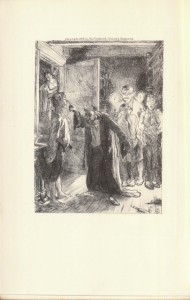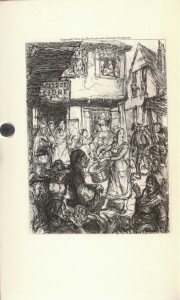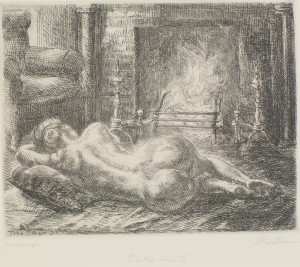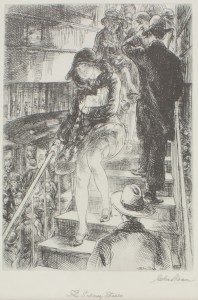This exhibition illuminates American artist John Sloan’s use of light to organize his compositions and to direct the viewer’s attention, highlighting subjects he considered significant. Born in 1871 and raised in Philadelphia, Sloan is best known for his Ashcan School brand of urban realism. Sloan’s interest in drawing began when he worked at Porter & Coates bookstore, where he copied from illustrations and prints. He enjoyed success as an illustrator of newspapers and magazines from 1890 until 1904, when this type of work became outmoded. Seeking new opportunities, Sloan joined his fellow Ashcan School artists in New York, where he worked with them on illustrations for a deluxe edition of satirical novels by Charles Paul de Kock, on view in this exhibition. Even as he created paintings, he continued making prints, producing an independent series entitled New York City Life, also on view here, that spotlights New Yorkers in public and private spaces, materializing an ambivalent social commentary. Throughout his artistic career, Sloan harnessed the nature of printmaking and its contrast of light and dark to illuminate scenes that might otherwise have remained in shadow.
Sloan’s Circle of Friends
Along with four of his friends, Robert Henri, William Glackens, George Luks, and Everett Shinn, Sloan trained at the Pennsylvania Academy of the Fine Arts and is best known as a member of two artist groups, the Ashcan School and The Eight. By 1904, Henri convinced the other four artists, then illustrators at The Philadelphia Press, to move to New York, where they worked and exhibited together. In Memory, Sloan recalled the comfortable friendship he and his wife Dolly enjoyed with Henri and his late wife Linda. The print’s title underscores Sloan’s preferred way of working from memory, and thus at a slower pace than his energetic line suggests. Henri often teased Sloan that his surname implied his slow speed, but Sloan embraced this, sometimes signing his work with the image of a snail.
 Memory
Memory
John Sloan
1906
Etching
Edition of 100
7 3/8 in. x 9 in. (18.73 cm x 22.86 cm)
Gift of Richard E. Bishop in memory of Mary E. Harrington
1962.151
Sloan met Robert Henri in 1892. Regarded as a talented painter and charismatic advocate of artistic independence, Henri became Sloan’s mentor and closest friend, greatly influencing the development of Sloan’s career. Henri encouraged Sloan in his graphic work such as using crayon and eventually convinced him to turn to painting. In Memory, Sloan highlights the important position of Henri in his life by situating Henri at his opposite at the table.
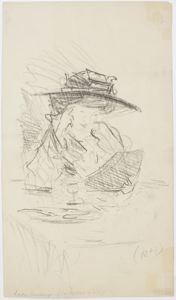
Lady Reading (verso); Couple in Profile (recto)
Robert Henri (or possibly John Sloan)
Late 19th century to early 20th century
Crayon
6 5/8 in. x 11 1/2 in. (16.83 cm x 29.21 cm)
Gift of Jacqueline Koldin Levine, Class of 1946, and Howard H. Levine
2012.27.172
Robert Henri was an advocate of painting from real life, paying particular attention to urban scenes. Henri brought together eight artists including Sloan for the 1908 exhibition at The Macbeth’s Gallery in New York. This exhibit sought to protest the established forms of high art from the conservative National Academy of Design. It ranked “The Eight” the first Americans in the century to venture into the modern mainstream and helped them become well-known.
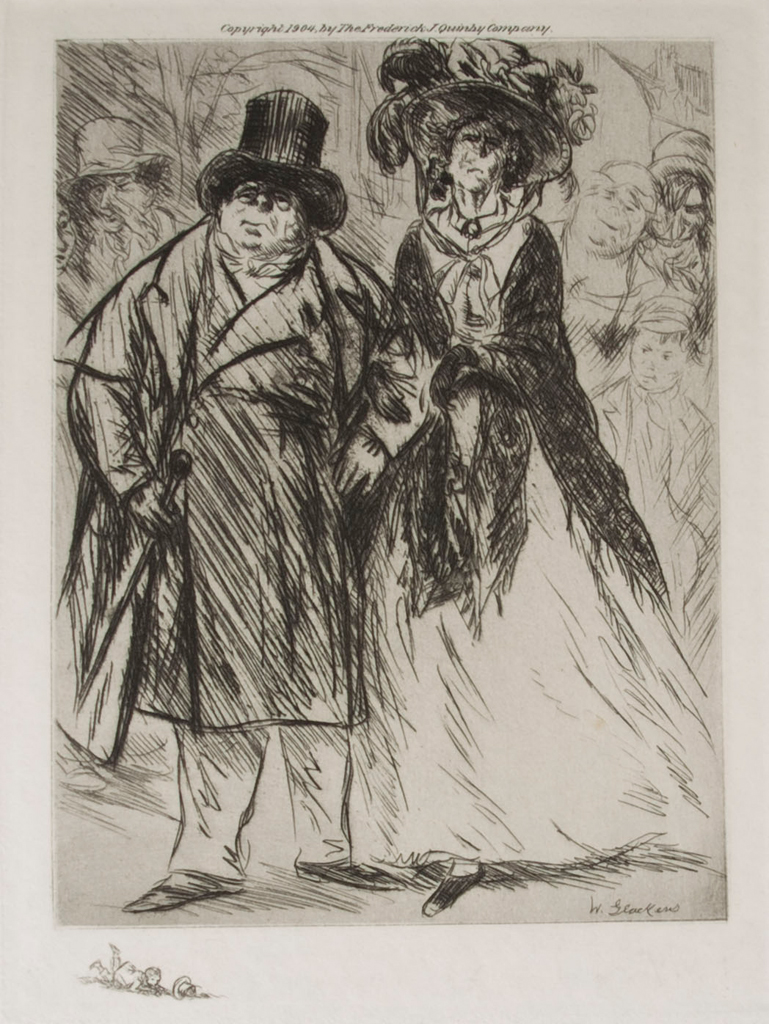
Monsieur and Madame Mollet
De Kock series, Stories of Parisian Life, Gregory Edition
William James Glackens
1904
Etching
5 7/8 in. x 4 3/8 in. (14.92 cm x 11.11 cm)
Gift of Richard E. Bishop in memory of Mary E. Harrington
1962.154.a
William Glackens, a member of “The Eight,” was longtime high school friends with Sloan. Glackens’ brilliant and expressive style, as seen in the etching Monsieur and Madame Mollet, inspired Sloan to depict his subjects under a broader urban context.
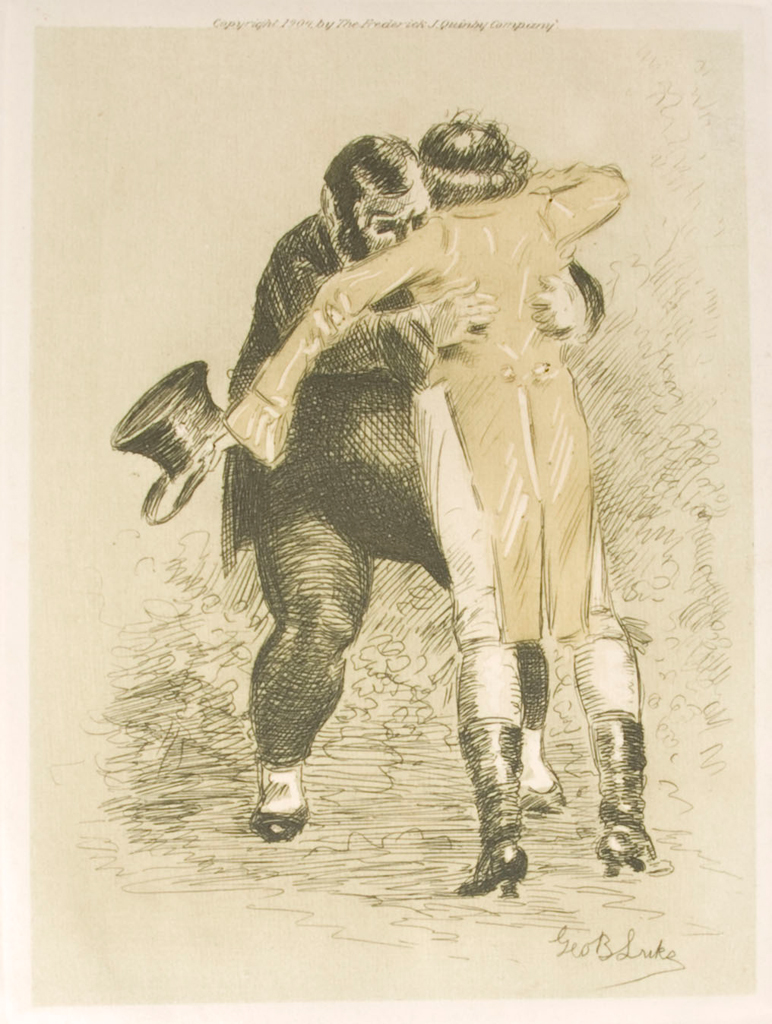
Two Drunk
George Benjamin Luks
1904
Etching
6 in. x 4 1/2 in. (15.24 cm x 11.43 cm)
Gift of Richard E. Bishop in memory of Mary E. Harrington
1962.153
While working at the Philadelphia Press, Sloan met George Luks. Sloan brought Luks into his artists circle and introduced him to Robert Henri. Luks was then profoundly influenced by Henri’s philosophy of painting urban-focused art, as seen in Luk’s realistic etching, Two Drunk.
Spotlight: Remarques in the Margins
In the illustrations for Charles Paul De Kock’s novels on view here, Sloan used remarques, small sketches made in the margins of an etching plate, to illuminate selected scenes. For Violette’s Suicide Prevented by Chicotin, Sloan depicted a candle, its flame not yet snuffed out, to highlight the heroine’s unsuccessful suicide attempt. Other remarques offer visual puns. In Ways of Drinking Champagne, Cupid tips over a glass of wine, suggesting alcohol’s aphrodisiac effect on the illustrated subjects. In The Silent Pie a man hides a trained songbird beneath the crust of a pie to woo his beloved. Although the depicted scene anticipates the bird’s performance, Sloan’s remarque of the trident and bird’s head hints at the bird’s actual fate: it has been baked along with the pie.
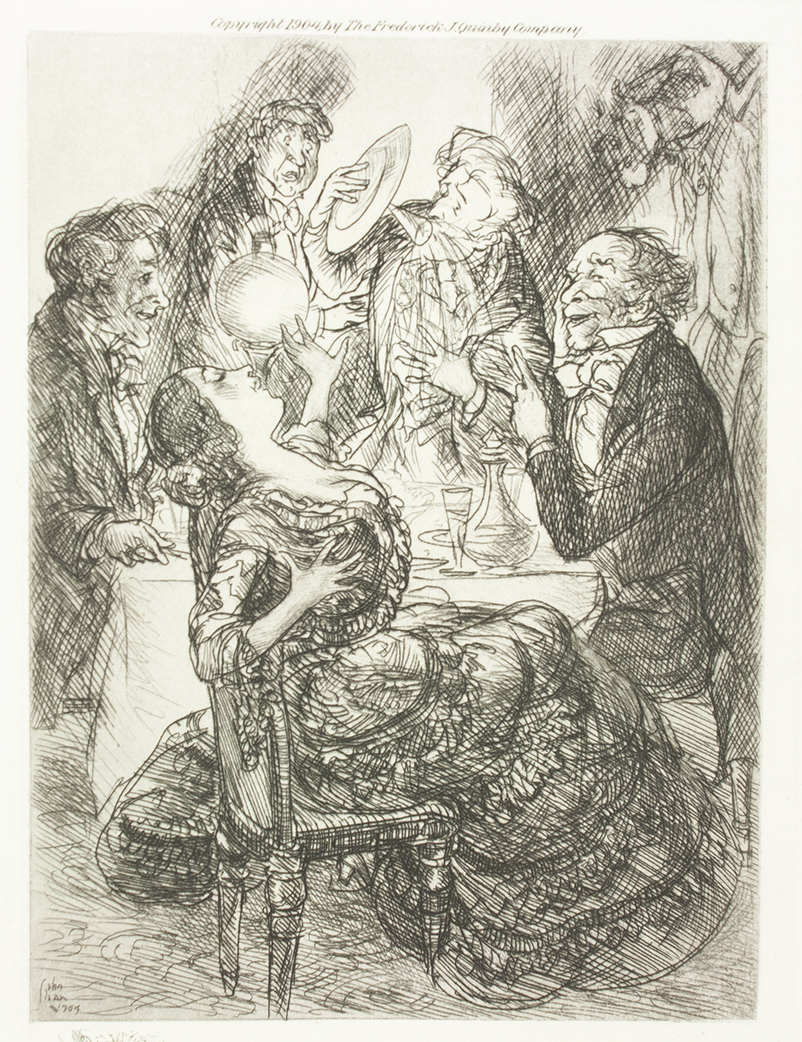
Ways of Drinking Champagne
De Kock series, The Flower Girl, vol.2, Saint Martin, Saint Gervais, and Memorial Editions
John Sloan
1904
Etching
6 in. x 4 1/2 in. (15.24 cm x 11.43 cm)
Gift of Richard E. Bishop in memory of Mary E. Harrington
1962.116.c
The cupid tipping over a glass of wine in the marginalia suggests that alcohol has an aphrodisiac effect on the woman figure in the center. See also Madame Putiphar and Chartreuse and Private Theatricals for comments on alcohol’s effects.
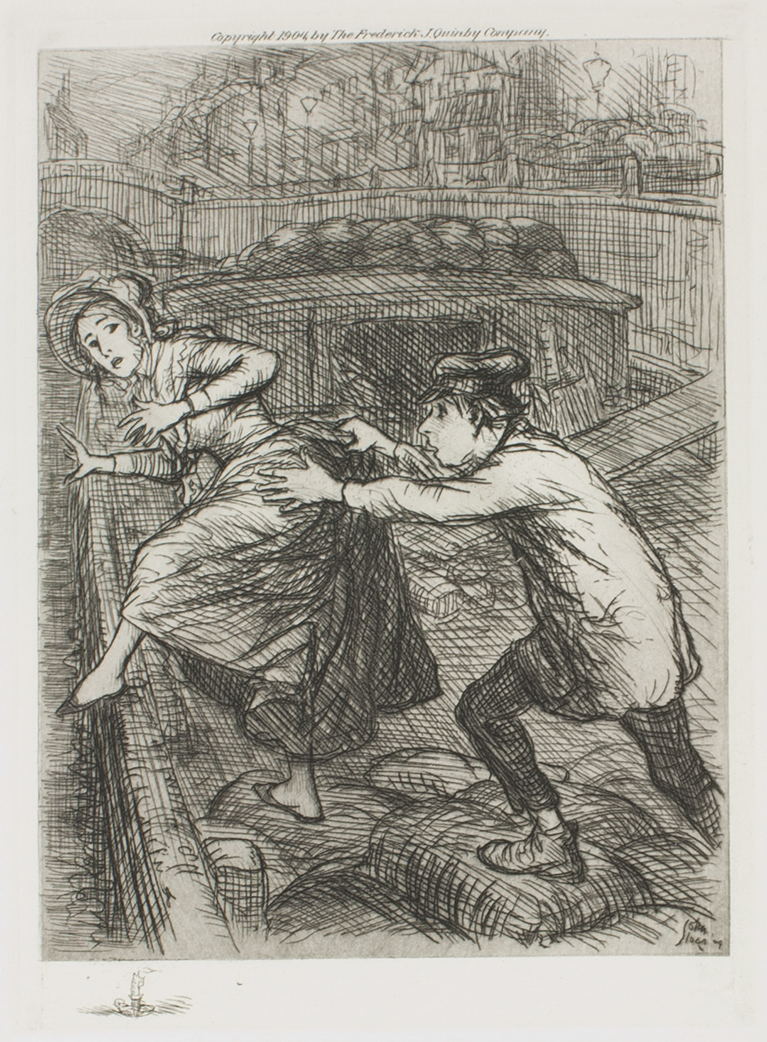
Violette’s Suicide Prevented by Chicotin
De Kock series, The Flower Girl, vol.2, Saint Martin, Saint Gervais, and Memorial Editions
John Sloan
1904
Etching
6 in. x 4 1/4 in. (15.24 cm x 10.8 cm)
Gift of Richard E. Bishop in memory of Mary E. Harrington
1962.124
Sloan also brings to light to artistic tradition in his marginalia. In this print, the candle, its flame not yet snuffed out, invokes the iconography of vanitas, a genre of still-life representing the transience of life, to highlight the heroine’s unsuccessful suicide attempt.
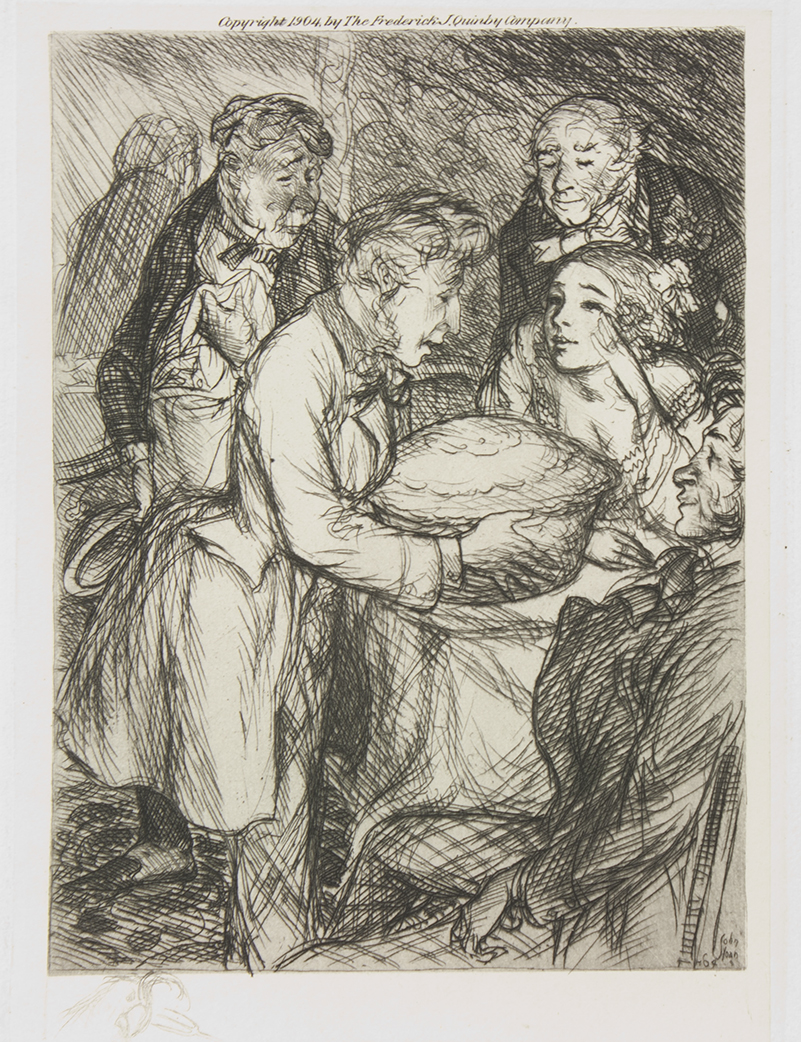
The Silent Pie
De Kock series, The Flower Girl, vol.2, Saint Martin, Saint Gervais, and Memorial Editions
John Sloan
1904
Etching
6 in. x 4 1/4 in. (15.24 cm x 10.8 cm)
Gift of Richard E. Bishop in memory of Mary E. Harrington
1962.122.a
In this print, a man hides a trained songbird beneath the crust of a pie in an effort to woo his beloved. Although the depicted moment anticipates the bird’s performance, Sloan’s remarque of the trident and bird’s head sheds light on the bird’s actual fate: it has accidentally been baked along with the pie.
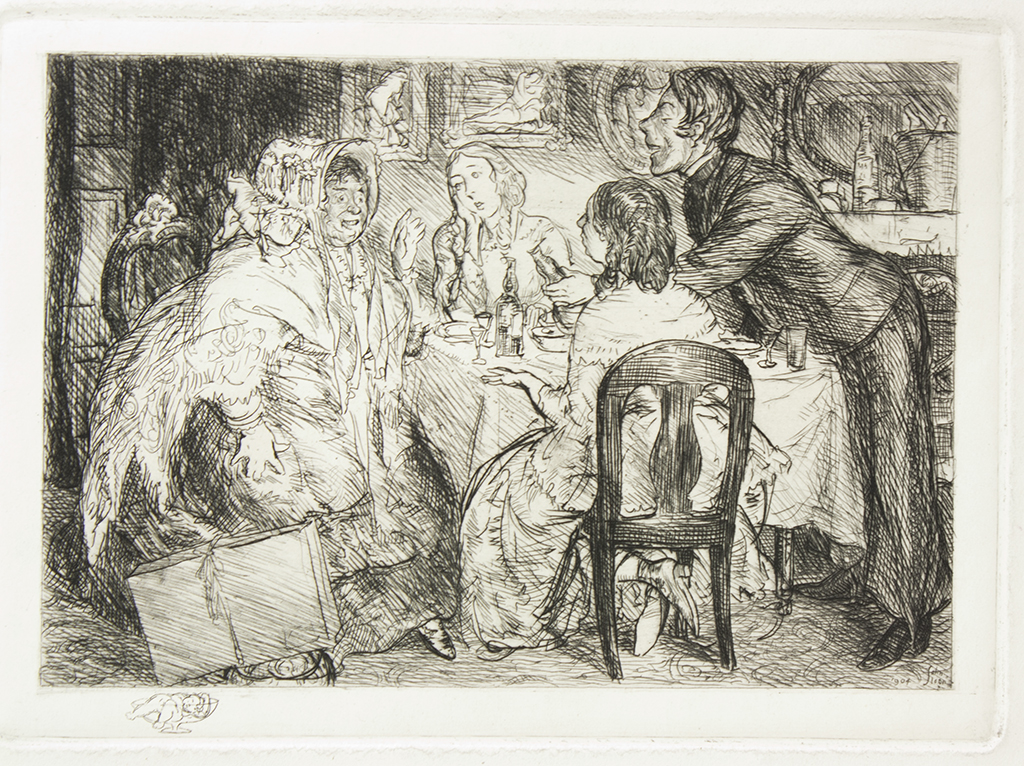
Madame Putiphar and Chartreuse
De Kock series, Adhémar, Saint Martin, Saint Gervais, and Memorial Editions
John Sloan
1904
Etching
4 1/2 in. x 6 1/4 in. (11.43 cm x 15.88 cm)
Gift of Richard E. Bishop in memory of Mary E. Harrington
1962.111
Looking at this print and Ways of Drinking Champagne, do you see a similarity? In the marginalia, the drunk chubby cupid in the wine glass in the marginalia hints at the plump woman on the left, possibly under the influence of alcohol too. See also Private Theatricals for its commentary on alcohol’s effects.
Illuminating the Story
The Frederick J. Quinby Company of Boston commissioned Sloan, among other Ashcan School artists, to illustrate English language translations of 19th-century novels by Charles Paul de Kock. These satirical novels share the social commentary of artist Honoré Daumier, De Kock’s contemporary in France, whose prints and caricatures Sloan studied. Sloan’s etchings for the deluxe editions were embraced for their handmade and autographic qualities. He illuminated playful parts of the plot with a charming lamp or eerie candles, such as those in Rossignol’s Drunken Advice to Pierre and the frontispiece of Frère Jacques I. In Monsieur Le Comte’s Fireworks Explode, the light source sweeps across the upper section of the print, animating the chaos of the scene.
Monsieur, pardon si je vous gêne un peu… (Sir, sorry if I bother you a bit…)
Les Bas-Bleus series, Le Charivari
Honoré Daumier
1844
Lithograph
7 5/8 in. x 8 5/8 in. (19.5 cm x 22 cm)
Janine Noack purchase through David Cook ‘64, gift in honor of Prof. Carol Solomon on loan from Haverford College, Special Collections
The nineteenth-century French printmaker Honoré Daumier greatly influenced Sloan’s work. The compositions of Daumier’s prints emphasize comedic elements and often comment on everyday social faux pas. Les Bas Bleus inspired Sloan’s use of light to draw the viewer’s attention to a particular figure in a print.
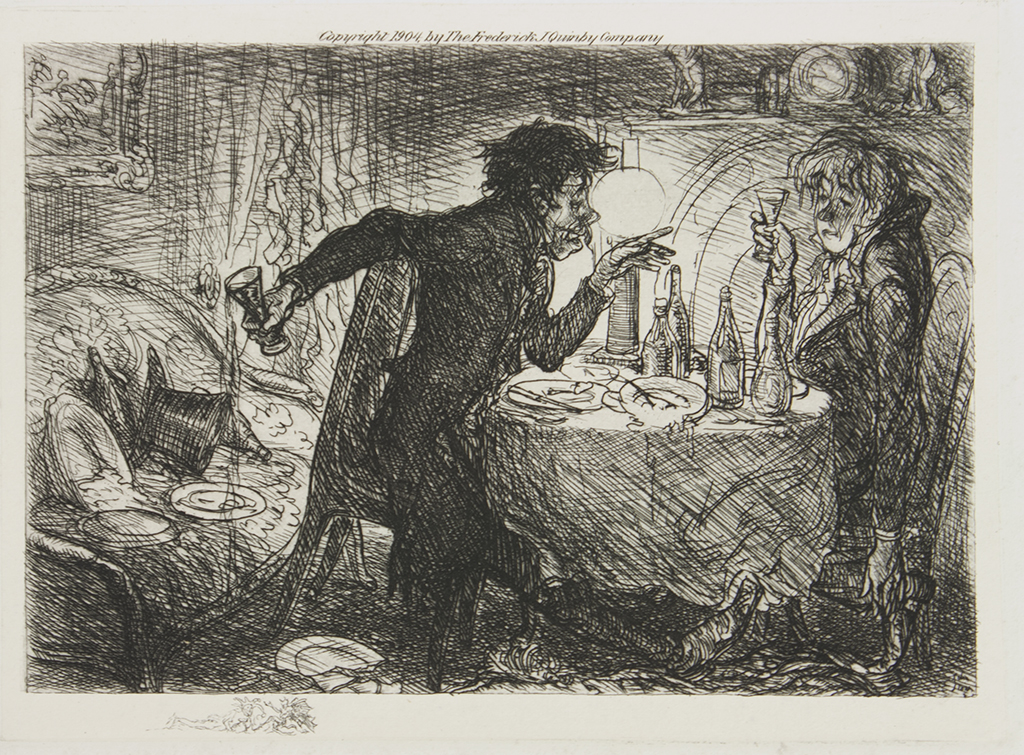
Rossignol’s Drunken Advice to Pierre
De Kock series, André the Savoyard, vol.2, Saint Martin, Saint Gervais, and Memorial Editions
John Sloan
1904
Etching
5 7/8 in. x 4 1/4 in. (14.92 cm x 10.8 cm)
Gift of Richard E. Bishop in memory of Mary E. Harrington
1962.125
Sloan uses the lamp as a powerful light source to silhouette the figures, drawing attention to and satirizing the flawed human nature of the characters. The contrast between the strong light source and the shadowed characters brings the story to life.
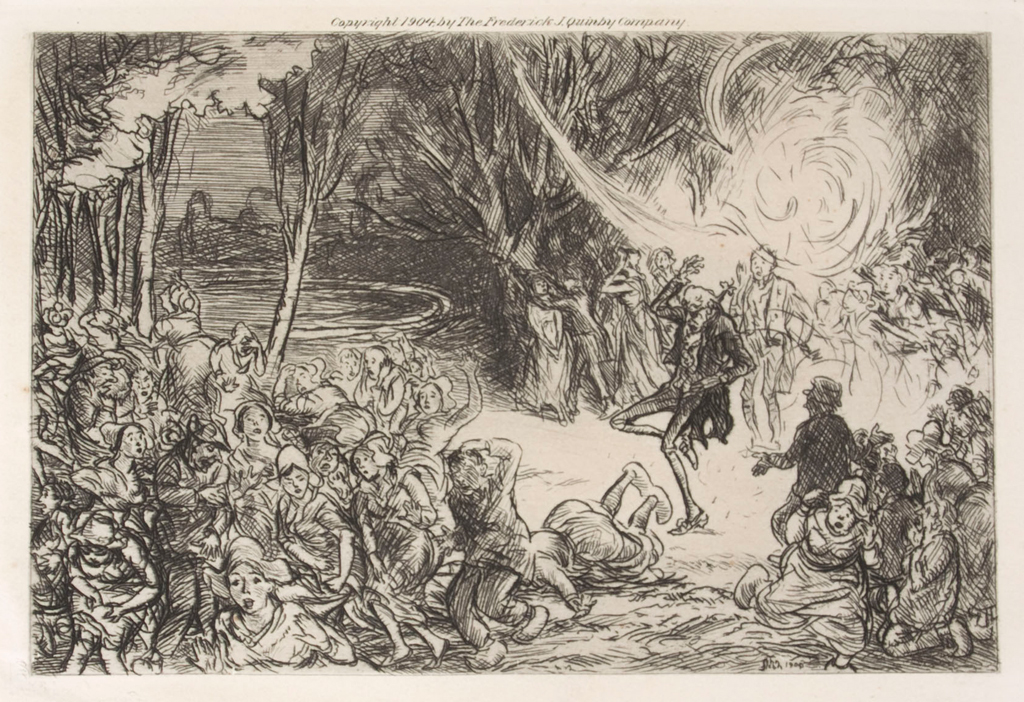
Monsieur Le Comte’s Fireworks Explode
De Kock series, André the Savoyard, vol.1, Saint Martin, Saint Gervais, and Memorial Editions
John Sloan
1904
Etching
4 3/8 in. x 5 7/8 in. (11.11 cm x 14.92 cm)
Gift of Richard E. Bishop in memory of Mary E. Harrington
1962.118.a
Sloan creates a very dynamic light source in this print that animates its theatrical narrative. The fireworks’ explosion acts as this light source, dramatically sweeping across the top of the print, heightening the chaos and anxiety as the characters attempt to escape the flames.
“He passed his hand several times before my face, and put his index finger to the end of my nose.”
De Kock series, Frère Jacques I, Gregory Edition, frontispiece
John Sloan
1902
Etching
8 3/8 in. x 5 1/2 in. (21cm x 14cm)
Gift of Dr. and Mrs. Albert L. Rosenthal
PQ2318.A26 1992 v.5
The luminous light source in the Frère Jacques frontispiece casts eerie shadows around the central figures, accentuating their sinister qualities. Drawing on the style of caricatures, Sloan highlights the comedic elements of the narrative by using light to exaggerate facial features and body language.
Spotlight: Madame Pantalon
Written in 1869, Charles Paul de Kock’s novel Madame Pantalon is an anti-feminist satire about a foolish group of bourgeois women, who declare themselves independent of men. The novel’s intended moral is made clear in its final line:
“Women have too many attractions, charms, grace, tact, and mischief to wish to abdicate the throne of women merely that they may resemble the masculine sex.”
Sloan’s illustrations, made 35 years later for an American audience, are not as clearly condemning as Honoré Daumier’s Les Bas-Bleus series. Although capable of Daumier’s visual satire as in “Madame Flambart left both her hands in the mortar,” Sloan reserved this for an ancillary character at a particularly slapstick moment of the novel. In Nanon Beats the Drum and The Boar Hunt, Sloan illustrated Nanon and the titular character Madame Pantalon, each at the center of the composition, looking capable and self-assured, rather than ridiculous. His proto-feminist sympathies allow him to read De Kock against the grain, illuminating the text in an unexpected way.
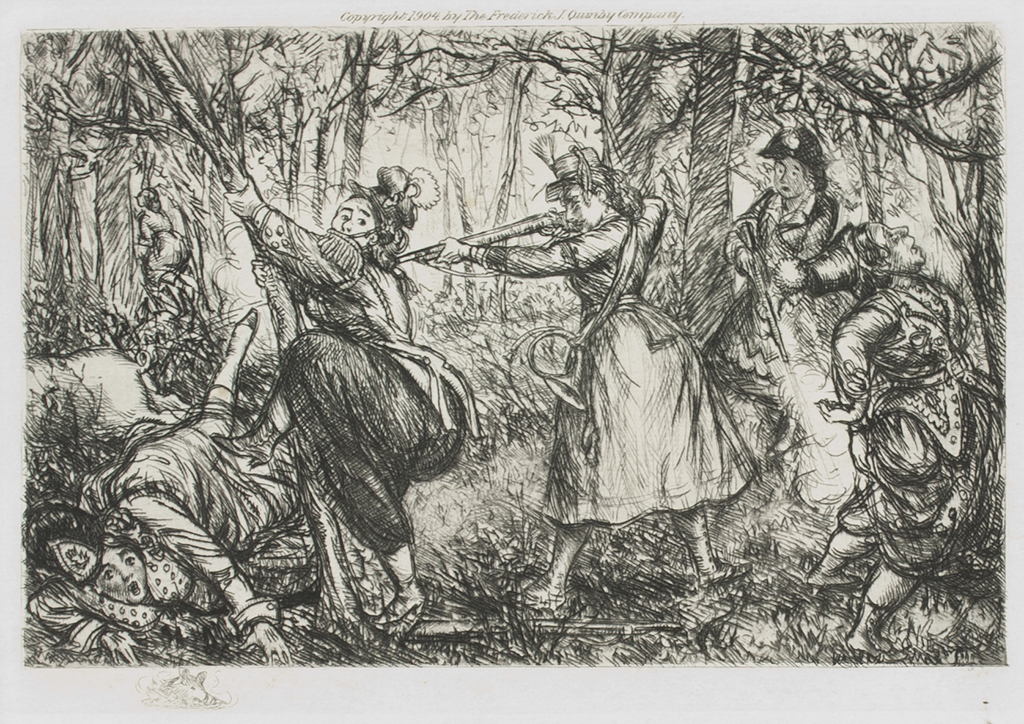
The Boar Hunt
De Kock series, Madame Pantalon, Gregory Edition
John Sloan
1904
Etching
4 1/4 in. x 6 in. (10.8 cm x 15.24 cm)
Gift of Richard E. Bishop in memory of Mary E. Harrington
1962.120.a
The central figure is Madame Pantalon, the instigator of the female “Independent” movement in the eponymous book by De Kock. Sloan renders her as a capable and self-assured woman whose strong pose contrasts with the stumbling, frightened, incompetent women beside her.
“Madame Flambart left both her hands in the mortar”
De Kock series, Madame Pantalon, Gregory Edition
John Sloan
1904
Facsimile of photogravure from original drawing
8 3/8 in. x 5 1/2 in. (21cm x 14cm)
Gift of Dr. and Mrs. Albert L. Rosenthal
PQ2318.A26 1992 v.21
In this print, one of the main characters, Madame Flambart, tries to take on the masculine job of building walls for peasants, yet gets her hands trapped in the cement. Her compromising pose and the chosen scene follow De Kock’s satire of the burgeoning feminist sensibility of the nineteenth century in Madame Pantalon.
Nanon Beats the Drum
De Kock series, Madame Pantalon, Gregory Edition, frontispiece
John Sloan
1904
Etching
8 3/8 in. x 5 1/2 in. (21cm x 14cm)
Gift of Dr. and Mrs. Albert L. Rosenthal
PQ2318.A26 1992 v.21
The image illustrates the moment when the central figure, Nanon, is about to make the proclamation. Her strong stance and determined face make her center of the crowd’s attention. Instead of faithfully following Madame Pantalon’s satire, Sloan reads author De Kock against the grain to illuminate the real independence of this “Independent.”
Spotlight: Sloan Lights Up the Scene
Light is directive in John Sloan’s prints, guiding the viewer to take note of specific elements. The contrast of light and dark illuminates small, characterizing details of individuals and their relationships to others and the world around them. By using light in this way, Sloan can show us intimate interior moments, such as those in Night Windows and Turning Out the Light. Or, he can use the spotlight as a distraction, showing us that the most interesting aspects of life are often overlooked in the shadows. In Anshutz on Anatomy and Private Theatricals, the dominant light source illuminates not only the stage, but also the audience. Sloan borrowed this compositional strategy from his illustration of de Kock’s novel for his more famous painting Movies, Five Cents (1907).
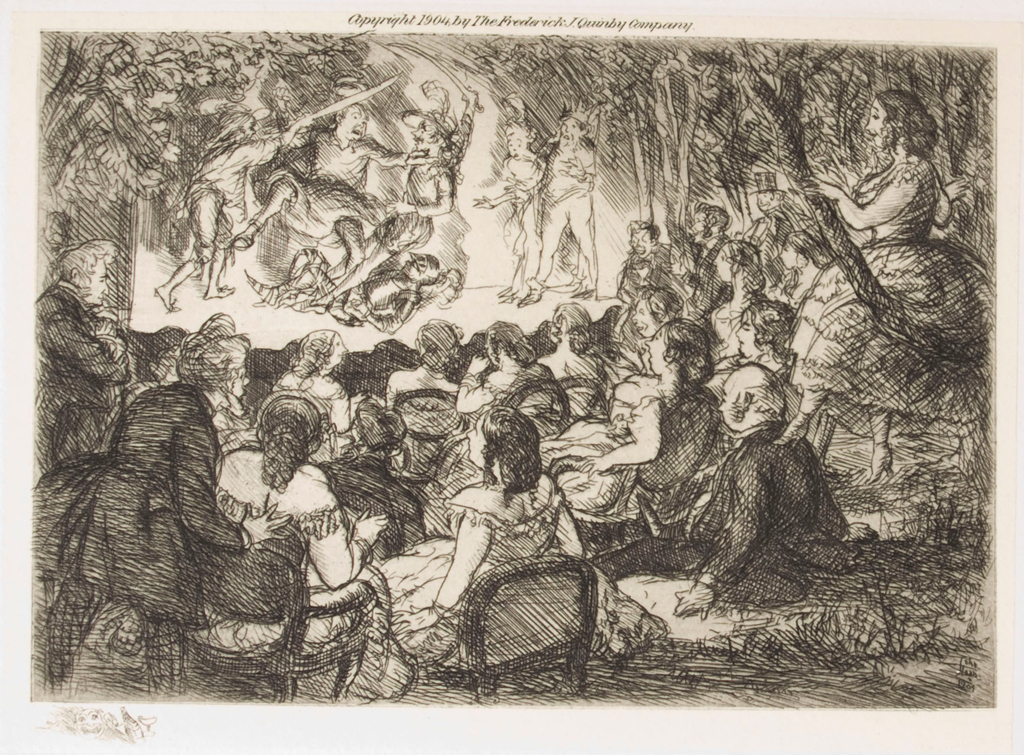
Private Theatricals
De Kock series, The Flower Girl, vol.1
John Sloan
1904
Etching
4 3/8 in. x 6 in. (11.11 cm x 15.24 cm)
Gift of Richard E. Bishop in memory of Mary E. Harrington
1962.108.c
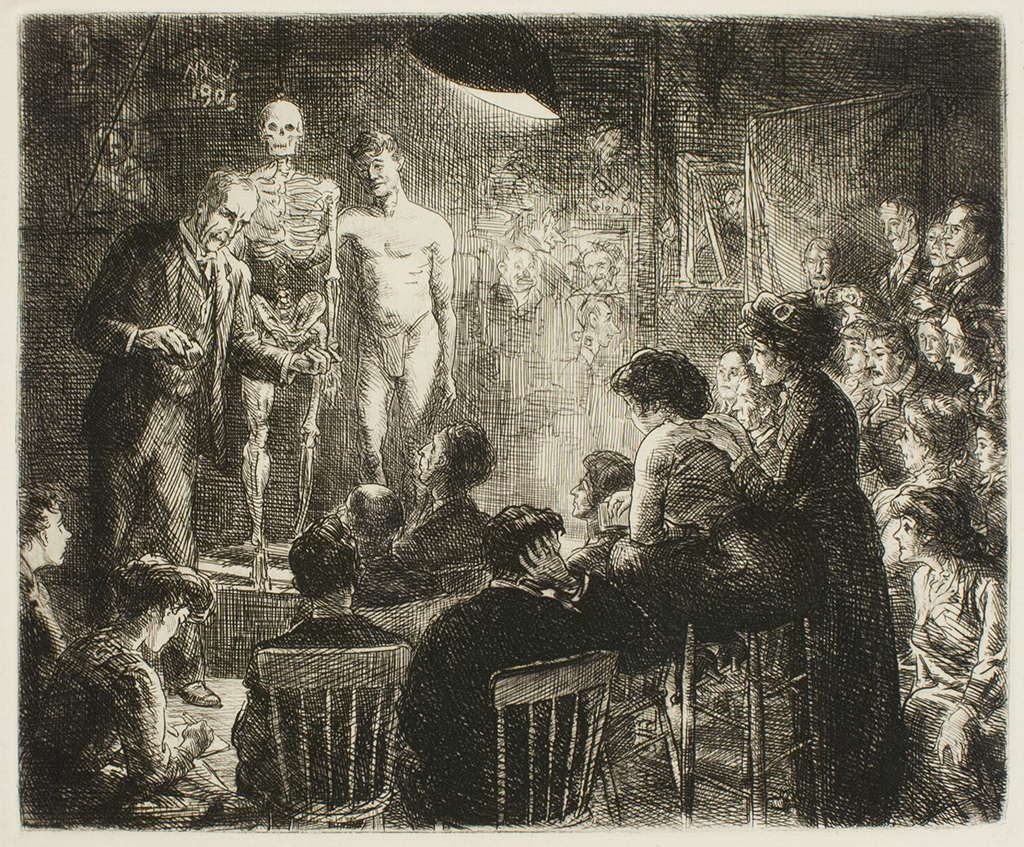
Anshutz on Anatomy
John Sloan
1912
Etching
Edition of 100
7 1/4 in. x 8 7/8 in. (18.42 cm x 22.54 cm)
Gift of Richard E. Bishop in memory of Mary E. Harrington
1962.140
Sloan uses light atypically in these scenes, illuminating both the stage and the typically shadowed audience. Masquerading as excess brightness from the stage spotlight(s), the light cast on the audience is intentional: drawing viewer’s attention to the social practices, economic status, and gender politics of the spectators. For Sloan, the audience is as interesting as what is on stage.
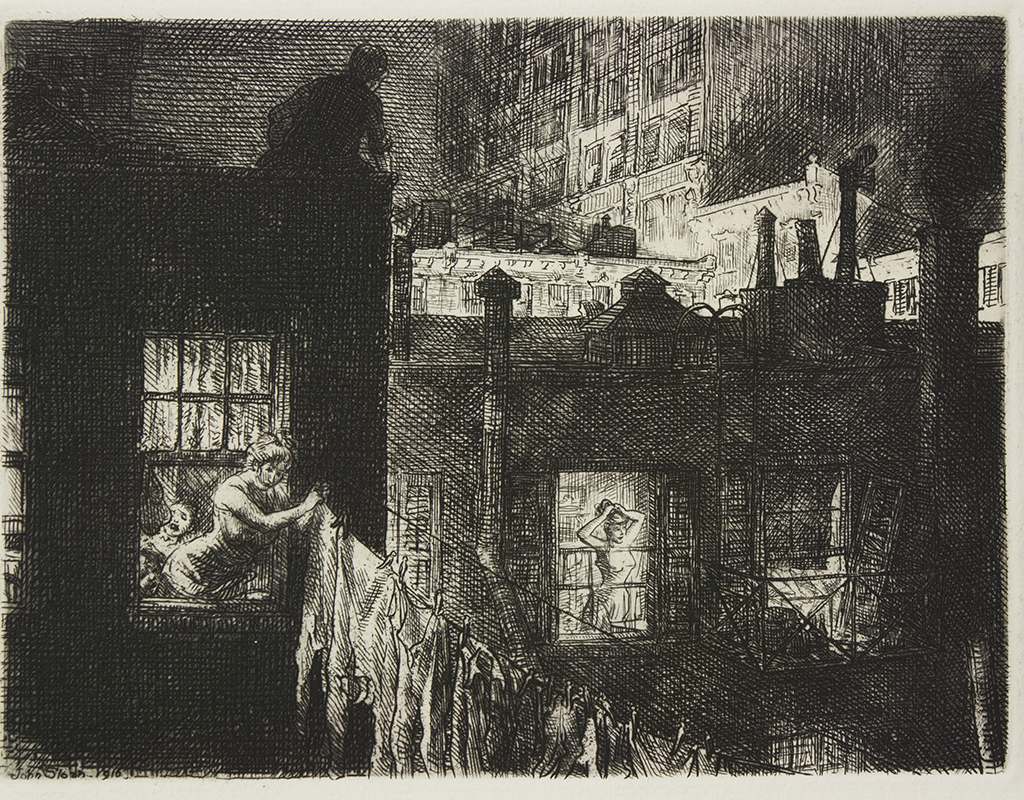
Night Windows
John Sloan
1910
Etching
Edition of 100
5 1/8 in. x 6 3/4 in. (13.02 cm x 17.15 cm)
Gift of Richard E. Bishop in memory of Mary E. Harrington
1962.150.b
The contrast of light and dark directs the eyes to images of quotidian life in early nineteenth-century New York City. In drawing attention to activities uncommonly highlighted such as hanging the laundry and dressing, Sloan emphasizes the universality of these actions.
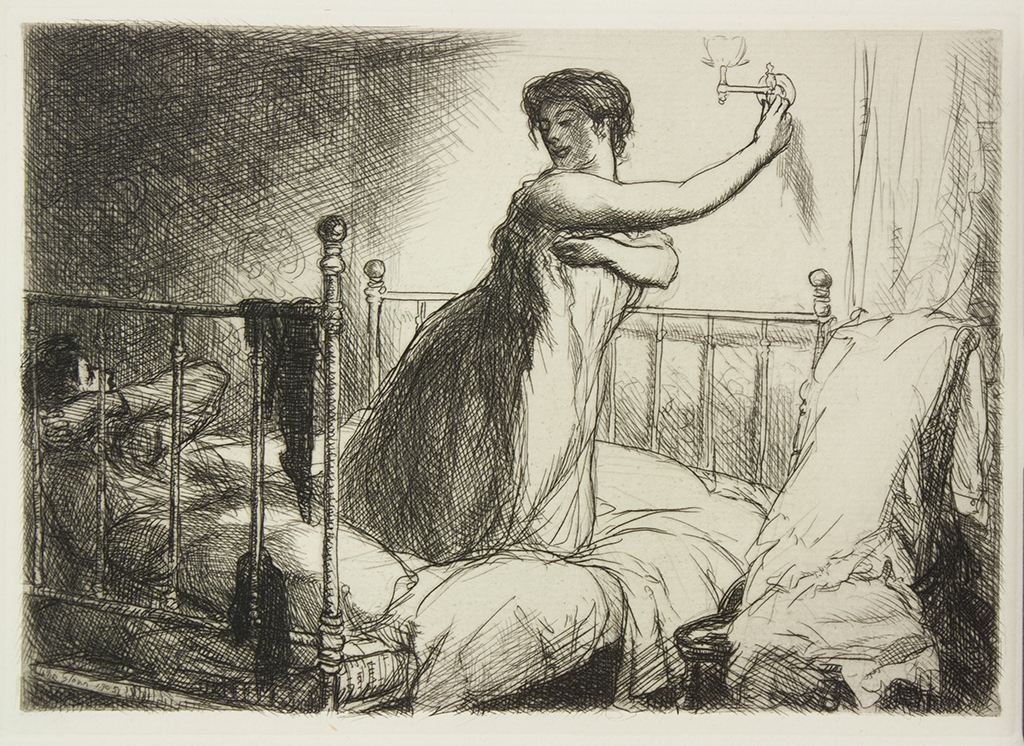
Turning Out the Light
New York City Life series
John Sloan
1905
Etching
Edition of 100
4 7/8 in. x 6 3/4 in. (12.38 cm x 17.15 cm)
Gift of Richard E. Bishop in memory of Mary E. Harrington
1962.146.b
Light in this scene is used to make a distinction between public and private space. Once the light is turned out, the room will be in darkness as the public (the gazing viewer) is removed from the privacy of this couple’s bedroom. It is important to note that it is the female figure that is given the agency to turn off the light and usher in the return of seclusion to the space.
Illuminating the Interior
In his depictions of domestic spaces, Sloan illuminated otherwise unseen interiors. Sometimes this is a voyeuristic intrusion, as in The Women’s Page. We look from behind at a woman absorbed in her reading. Our trespass is softened by the ray of sunlight illuminating the paper, which reminds us that the outside world has already entered her bedroom. In other prints, our entry feels invited, met with a warm and familiar look, as in Mother. Light shines across the wall in Man, Wife, and Child, joining us with this happy moment. But our intrusion is not as welcomed by the woman in Turning Out the Light, who reaches for the light switch. Is she just about to regain control, by plunging the room into darkness?
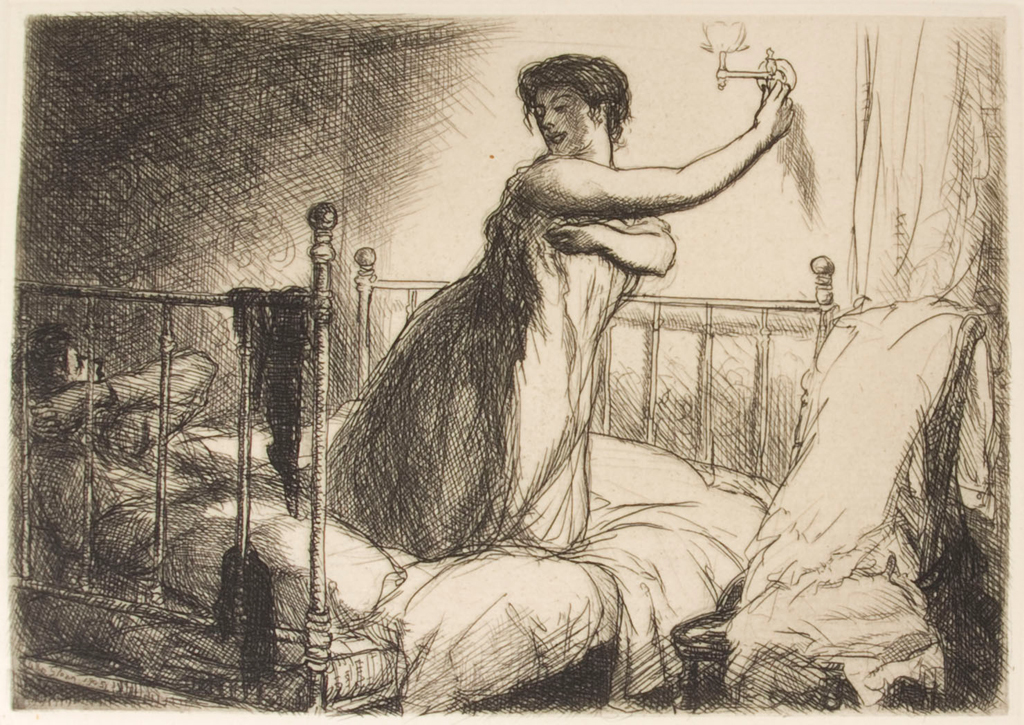
Turning Out the Light
New York City Life series
John Sloan
1905
Etching
Edition of 100
4 7/8 in. x 6 3/4 in. (12.38 cm x 17.15 cm)
Gift of Richard E. Bishop in memory of Mary E. Harrington
1962.146.a
Sloan illuminates an intimate bedroom scene in Turning out the Light. The lamp casts its bright, round glow on the comfortably rumpled bedding and on the clothes hanging on the chair. The man is just outside the light’s reach, in softly defined shadow. The woman reaches for the light switch, preserving the scene’s intimacy by extinguishing the light.
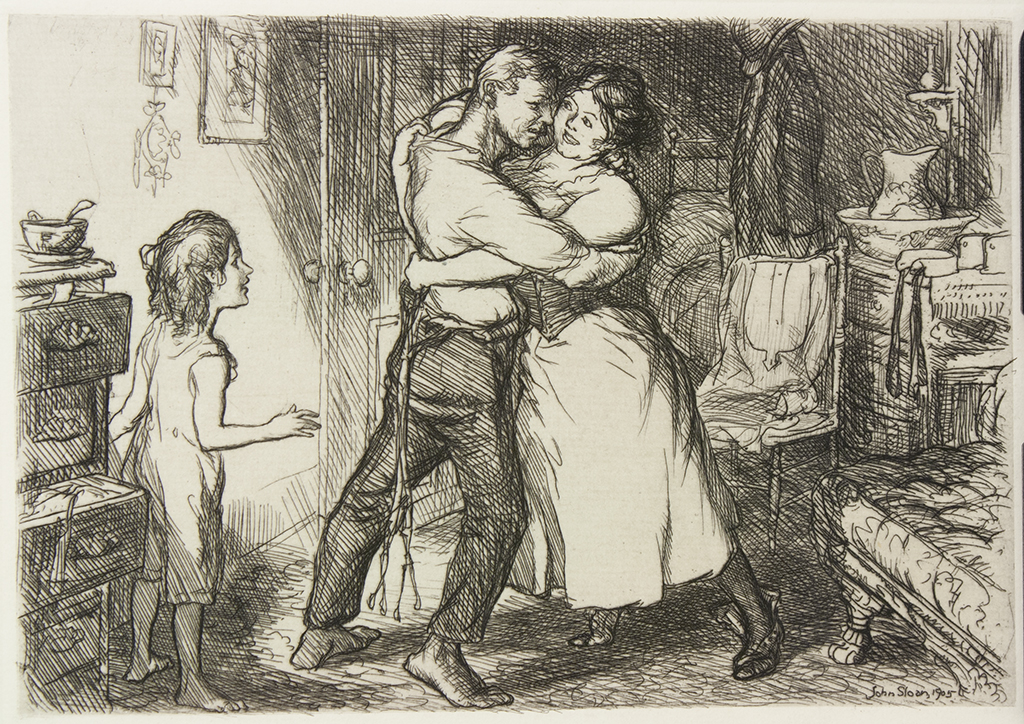
Man, Wife, and Child
New York City Life series
John Sloan
1905
Etching
Edition of 100
4 7/8 in. x 6 3/4 in. (12.38 cm x 17.15 cm)
Gift of Richard E. Bishop in memory of Mary E. Harrington
1962.145
Man, Wife, and Child is one of several comfortable, working-class domestic scenes that Sloan set in a bedroom, with clothes draped on chairs and drawers ajar. The couple, both in states of undress—the man with his suspenders dangling and the woman in a corset and unlaced boots—dance in a beam of light so bright, it’s as if they’re performing the rituals of marriage on stage.
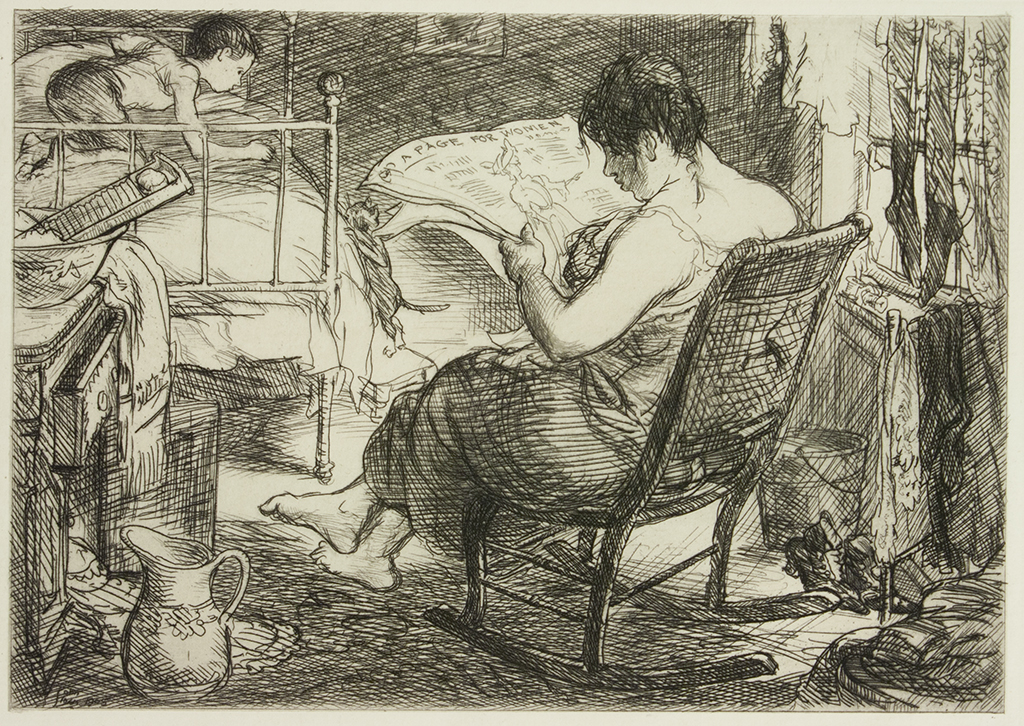
The Women’s Page
New York City Life series
John Sloan
1905
Etching
Edition of 100
4 3/4 in. x 6 3/4 in. (12.07 cm x 17.15 cm)
Gift of Richard E. Bishop in memory of Mary E. Harrington
1962.147.b
In The Women’s Page, we seem to sneak up on the woman reading the leisure section of the newspaper as she takes a break from her laundry and washboard. Soft afternoon light comes in through the window, casting the messy bedroom into shadow. A child plays with a cat on the bed in the background. Does Sloan depict a mother neglecting her child and domestic work or a hard-working woman taking a break from the domestic realm to enter the outside world?
Nude on Hearth
John Sloan
1933
Etching
Edition of 100
5 1/2 in. x 6 7/8 in. (13.97 cm x 17.46 cm)
Gift of Jacqueline Koldin Levine, Class of 1946, and Howard H. Levine
2012.27.165
Nude on Hearth is one of several domestic scenes in which Sloan approaches the female subject who has her back turned, with a possibly intrusive artistic motive. Here, the low glow of the fire, which doesn’t totally illuminate the woman, and the affectionately detailed musculature of her back make this relaxed, intimate scene one in which the viewer seems to be welcome. The artist doesn’t capture a hurried glance, but takes a long, slow look.
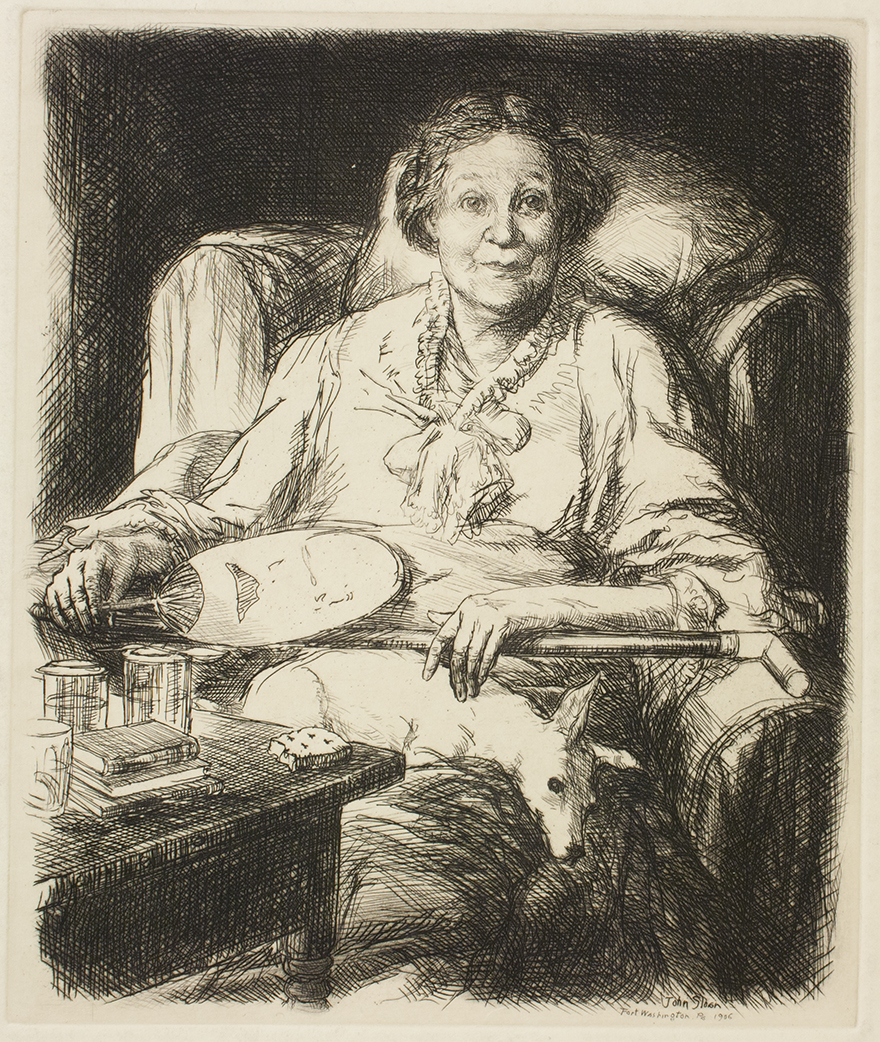
Mother
John Sloan
1906
Etching
Edition of 100
8 7/8 in. x 7 1/2 in. (22.54 cm x 19.05 cm)
Gift of Richard E. Bishop in memory of Mary E. Harrington
1962.152
In Mother, Sloan’s familiarity with the subject lets him create a lovingly detailed portrait of his own mother. There is a warm contrast between light and dark; the artist’s brightly illuminated mother practically glows against the rich, black background. The shadows and the woman’s direct stare make the print’s setting a cozy space for two.
Illuminating the City and its Disparities
Inspired by the New York City streets, Sloan’s prints highlight the social disparities between the people who shared this urban space. The strewn rice in The Little Bride points to the class disparity between the lightly-rendered bride and the barely visible figures at the margin. In The Show Case, the corset on display attracts the attention of young girls, who catch the eye of a nearby upper-class man. One girl notices the woman accompanying this man, whose parallel position with the cased corset reminds us of the unseen undergarment she likely wears. While Sloan’s subjects seem to share a lightness of skin color, the recent waves of immigrants depicted in The Wake on the Ferry might not have had access to a more privileged racial status of whiteness.
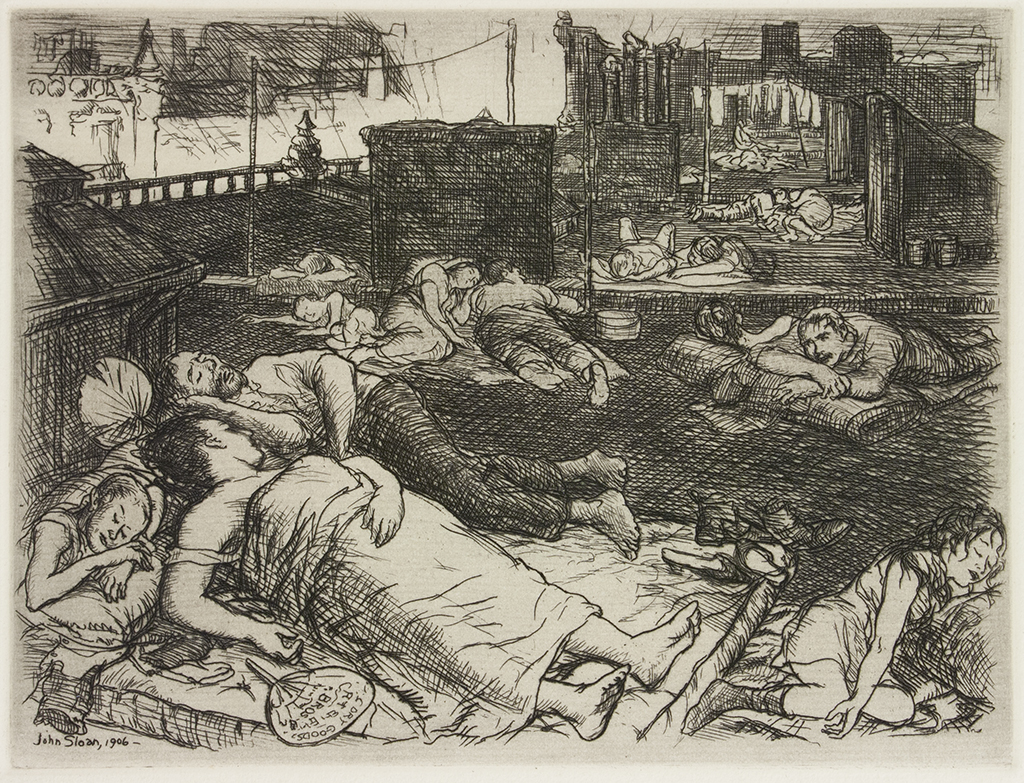
Roofs, Summer Night
New York City Life series
John Sloan
1906
Etching
Edition of 100
5 1/8 in. x 6 3/4 in. (13.02 cm x 17.15 cm)
Gift of Richard E. Bishop in memory of Mary E. Harrington
1962.148.b
The contrast between the shadowed tenement rooftop and the light figures strewn across the scene in this print highlights Sloan’s connection with working people and his desire to illuminate their stories and struggles.
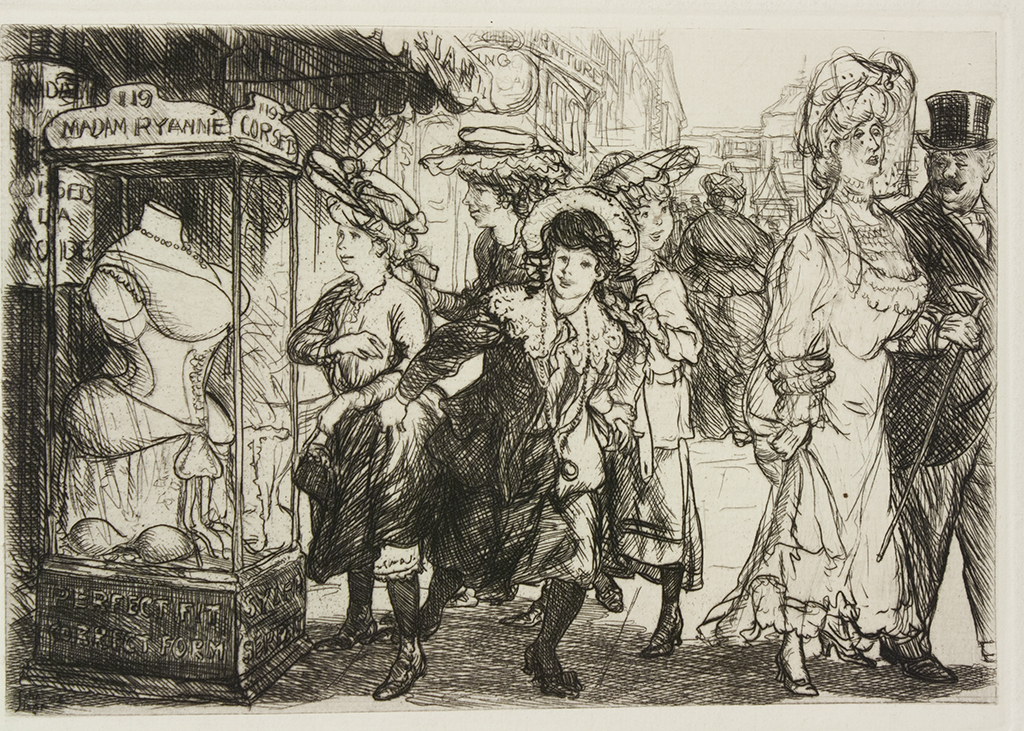
The Show Case
New York City Life series
John Sloan
1905
Etching
Edition of 100
4 7/8 in. x 6 7/8 in. (12.38 cm x 17.46 cm)
Gift of Richard E. Bishop in memory of Mary E. Harrington
1962.142
In this print, young women gleefully run past a high fashion corset while an upper-class couple walks by. The young, underdeveloped girls in the print seem to be of a working class that would not be able to afford such costly undergarments. To emphasize this disconnect between the classes of the figures, Sloan connects the gaze of one of the young girls and the older wealthy man. By having these two groups interact in a morally ambiguous way, Sloan enforces the idea of capitalism exploiting people’s consciousness. This work highlights the intersection of masculine and feminine spaces and different classes in the shared space of city streets.
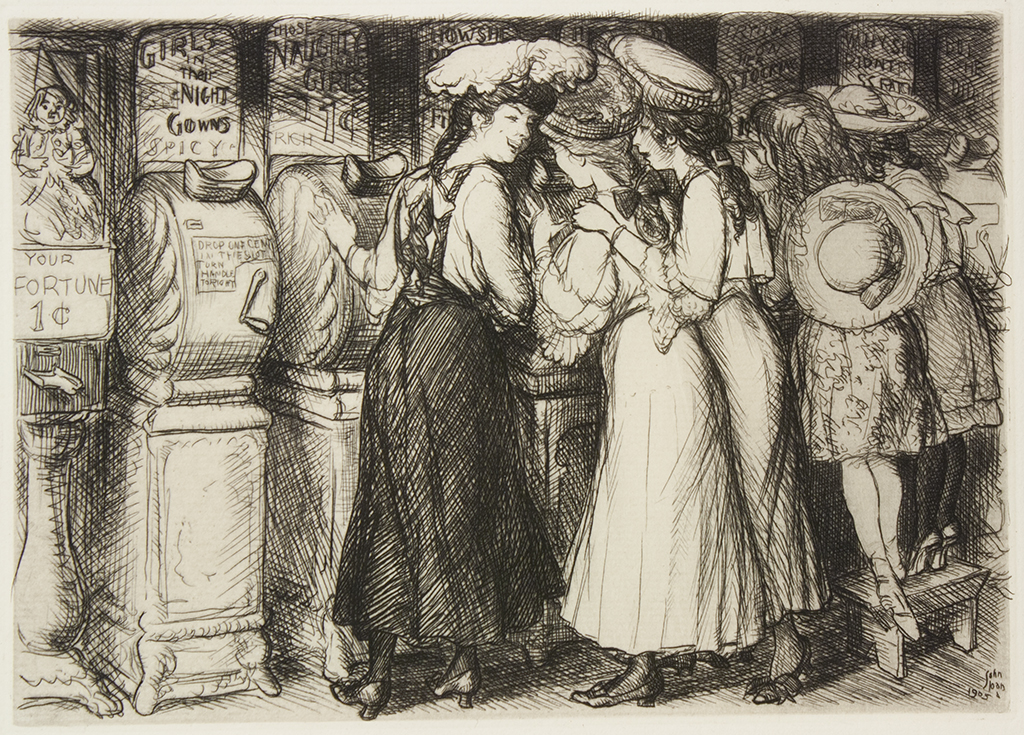
Fun, One Cent
New York City Life series
John Sloan
1905
Etching
Edition of 100
4 7/8 in. x 6 3/4 in. (12.38 cm x 17.15 cm)
Gift of Richard E. Bishop in memory of Mary E. Harrington
1962.112
A crowd of young women huddles around a vitascope, an early film projector patented in 1895. Using light, Sloan casts a spotlight on the girls while keeping the provocative names of the films – “Girls in their Night Gowns” and “Those Naughty Girls” – in the shadows. In this print, Sloan is brings to light new leisure activities for urban working women in the early 20th century.
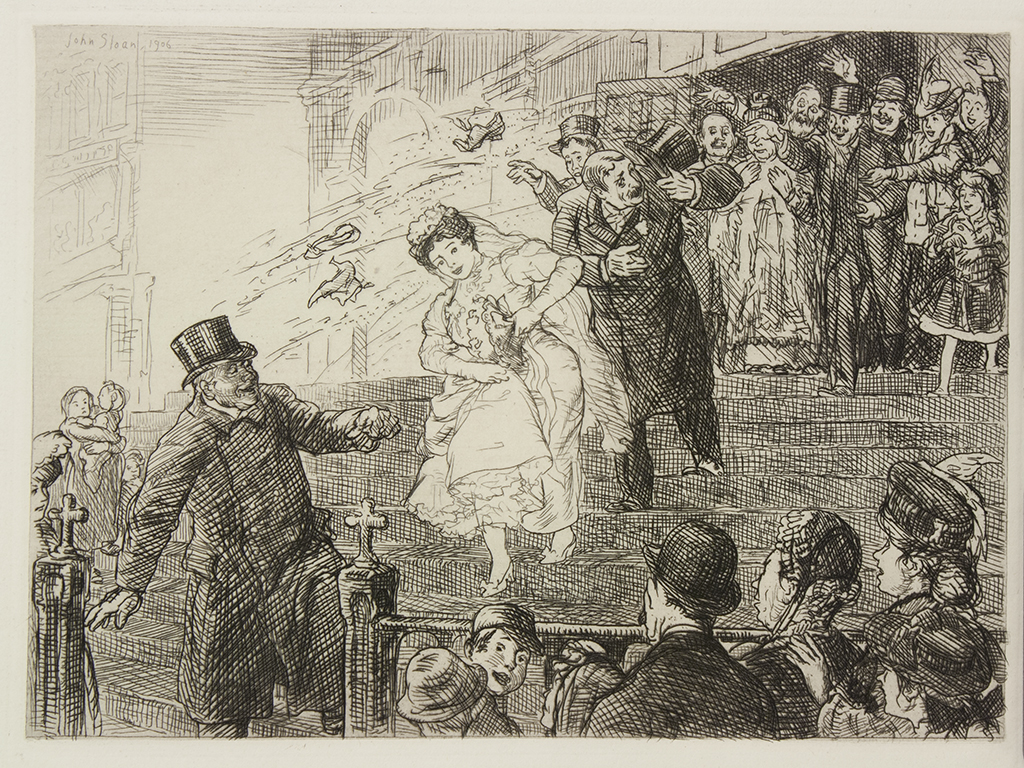
The Little Bride
New York City Life series
John Sloan
1906
Etching
Edition of 100
5 in. x 6 3/4 in. (12.7 cm x 17.15 cm)
Gift of Richard E. Bishop in memory of Mary E. Harrington
1962.149.b
In this print, the strewn rice and objects seem to point toward the uninvited guests at the margin. Even in this celebratory scene, using dark and light contrast Sloan highlights the class disparity between the central and surrounding figures. At the top of the stairs, the hand of one guest cover the eyes of the clergyman who has just married the couple, showing us that he too is blinded to the contrast between these simultaneous realities.
Subway Stairs
John Sloan
1926
Photomechanical print
6 7/8 in. x 4 7/8 in. (17.46 cm x 12.38 cm)
Gift of Jacqueline Koldin Levine, Class of 1946, and Howard H. Levine
2012.27.169
In this busy urban scene in a subway station, Sloan directs the light upwards to draw the viewer’s attention to the central female figure. Like in many of his prints, Sloan uses contrast to illuminate the lives of those who might otherwise be overlooked in the city.
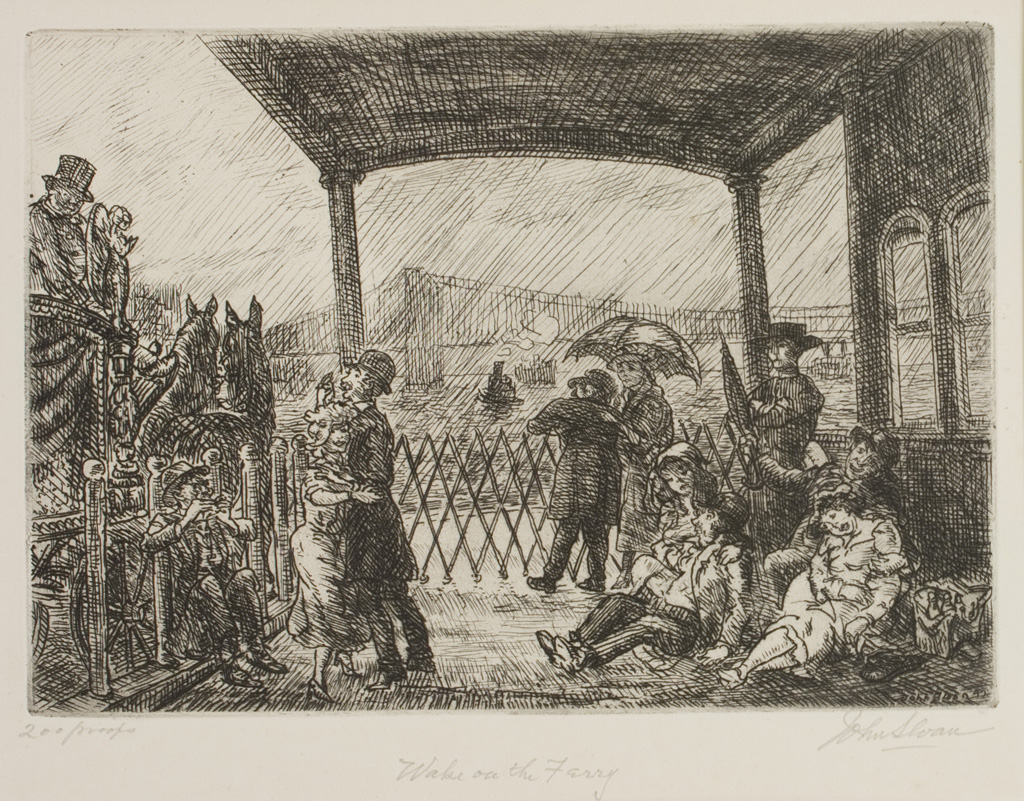
The Wake on the Ferry
John Sloan, printed by Ernest D. Roth
1949
Etching
Edition of 350
5 in. x 7 in. (12.7 cm x 17.78 cm)
Bequest of John Nichols Estabrook and Dorothy Coogan Estabrook
JNE.P.30
While Sloan’s depictions of city life often do not feature major monuments identifying it as New York, this print is an exception. The Brooklyn Bridge frames the illuminated figures in the foreground of the print, though Sloan does not emphasize the architectural structure as much as he does the city dwellers and their stories. In this print, Sloan’s subjects share a lightness of skin color, though not all with light skin had access to the privileged status of whiteness at this time, such as the recent waves of immigrants depicted here.
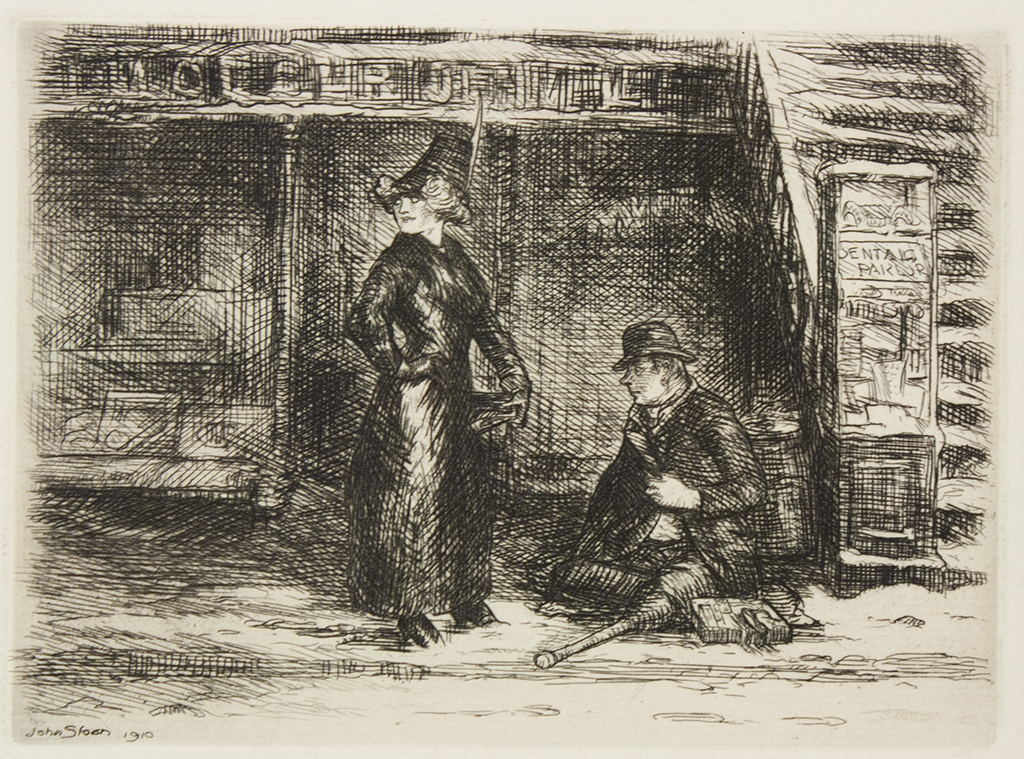
Girl and Beggar
John Sloan
1910
Etching
Edition of 100
4 3/8 in. x 5 7/8 in. (11.11 cm x 14.92 cm)
Gift of Richard E. Bishop in memory of Mary E. Harrington
1962.115.b
In this print, Sloan features two figures, one male and one female. Both the beggar and the prostitute solicit money in their own way. By keeping both mostly in shadow, Sloan understands their lives as similar and unseen.
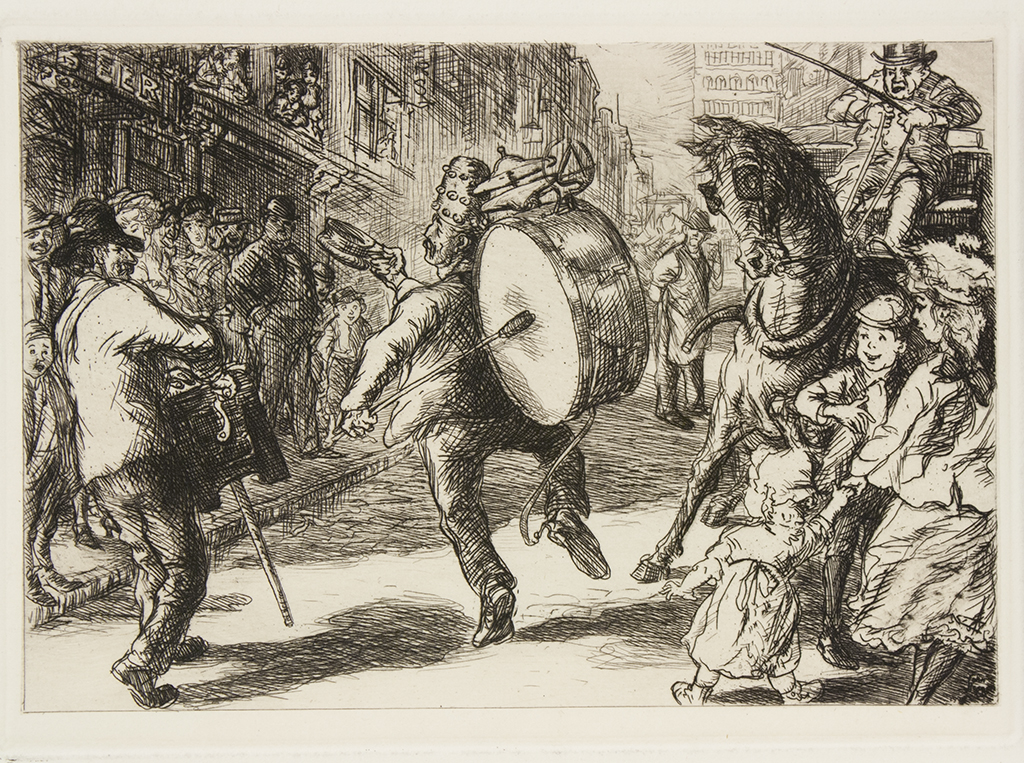
Man Monkey
New York City Life series
John Sloan
1905
Etching
Edition of 100
5 in. x 6 7/8 in. (12.7 cm x 17.46 cm)
Gift of Richard E. Bishop in memory of Mary E. Harrington
1962.143
The central figure of the Man Monkey draws the attention of the street with his performance. The light draws our attention to his cap offered to the crowds for some coins.
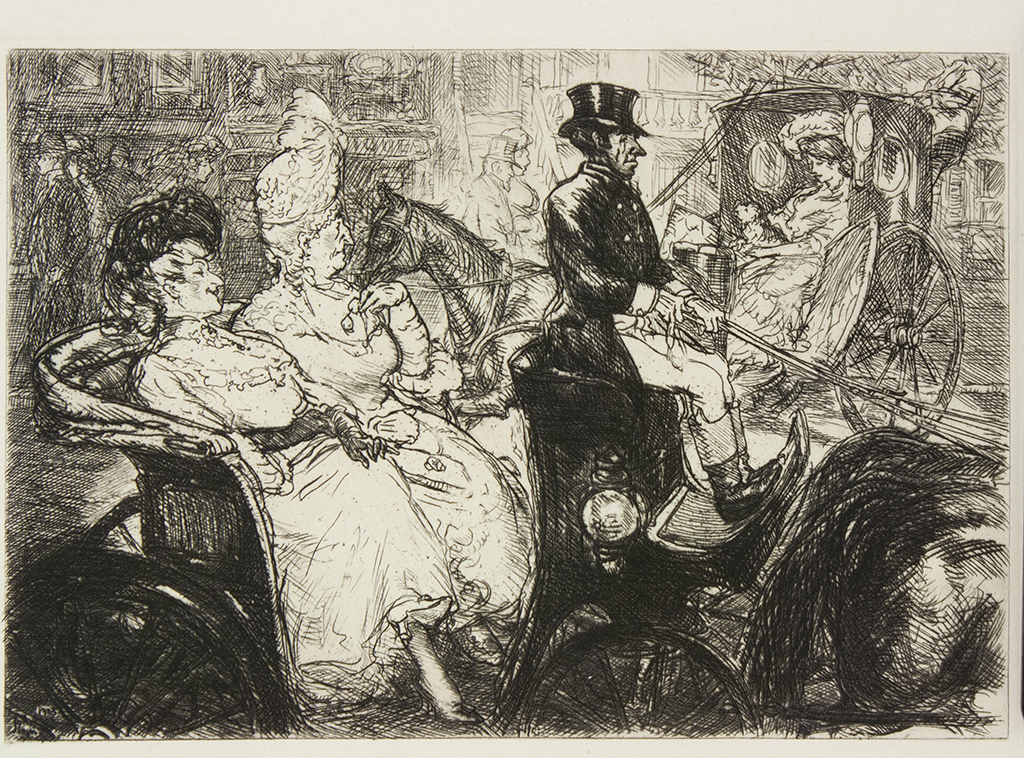
Fifth Avenue Critics
New York City Life series
John Sloan
1905
Etching
Edition of 100
4 7/8 in. x 6 3/4 in. (12.38 cm x 17.15 cm)
Gift of Richard E. Bishop in memory of Mary E. Harrington
1962.144.a
In this print Sloan sets up a contrast between the lightly rendered wealthy female figures and the dark carriage driver. These two simultaneous realities that Sloan spotlights are representative of the true tension in the city streets.
Spotlight: Drumming Up Support
Of the many plots in Charles Paul de Kock’s novels, Sloan chose to illustrate two scenes with drummers. He designed each composition around these figures. In Nanon Beats The Drum, Sloan placed a woman drummer near the center of the print, encircled by onlookers. In the story, Nanon illegitimately seizes the right to drum from the town’s rural guard. In contrast to de Kock’s story, Sloan dignifies her. He then borrowed this sympathetic treatment of the drummer for his New York Life series. In Man Monkey, the lightest part of the street surface becomes the spotlighted stage for a street performer.

Man Monkey
New York City Life series
John Sloan
1905
Etching
Edition of 100
5 in. x 6 7/8 in. (12.7 cm x 17.46 cm)
Gift of Richard E. Bishop in memory of Mary E. Harrington
1962.143
Sloan depicts the drummer in a positive light, situating him in a crowd of people who seem to be joyfully responding to the performance. It is possible that Sloan is suggesting that the idea of the drummer as a self-portrait.
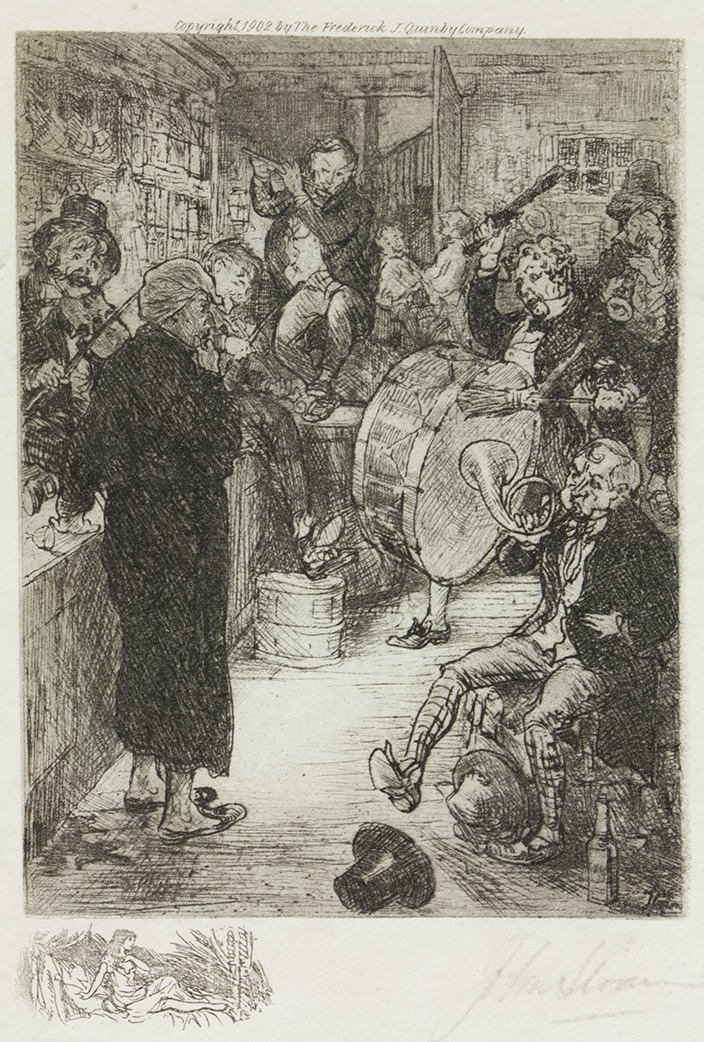
The Serenade
De Kock series, Saint Martin, Saint Gervais, and Memorial Editions, Monsieur Dupont, vol.2,
John Sloan
1902
Etching on vellum
5 7/8 in. x 4 1/4 in. (14.92 cm x 10.8 cm)
Gift of Richard E. Bishop in memory of Mary E. Harrington
1962.138
The title suggests that Sloan favors these musicians and their music. By placing the light on the drummer, the viewers’ attention is captured, thus making him the focal point of the print. Sloan’s idea of the favorable drummer translates onto several of his works.

Nanon Beats the Drum
De Kock series, Gregory Edition, Madame Pantalon
John Sloan
1904
Etching
6 in. x 4 1/4 in. (15.24 cm x 10.8 cm)
Gift of Richard E. Bishop in memory of Mary E. Harrington
1962.126
Sloan depicts Charles De Kock’s Nanon differently in this print. Not only is she the center of attention, but she also appears dignified amongst the crowd, contrasting De Kock’s anti-feminist intention of a sillier Nanon. This disregard for her original characteristics shows Sloan’s stance on the status of women.
Illuminating the Illuminati
Sloan often turned his critical eye to the social hierarchies of the art world. In Copyist at the Metropolitan Museum, Sloan indicated a distinction between the original and the lesser-valued copy painted by a female. But, Sloan’s print copies her copy. He signals this ambivalence through his self-portrait at left, turning his back on the sheep-like crowd, while also casting a glance backward to see. In Connoisseurs of Prints he depicts another gallery crowd, this one surrounding two pompous men at the center. Are these the titular connoisseurs? Perhaps, but their animated discussion distracts them from the prints. The man in white undermines their authority, scrutinizing a print through a magnifying glass. But the most active and eager art-viewer is the nearly obscured woman to his left. Sloan rewards our inspection of his print with this discovery.
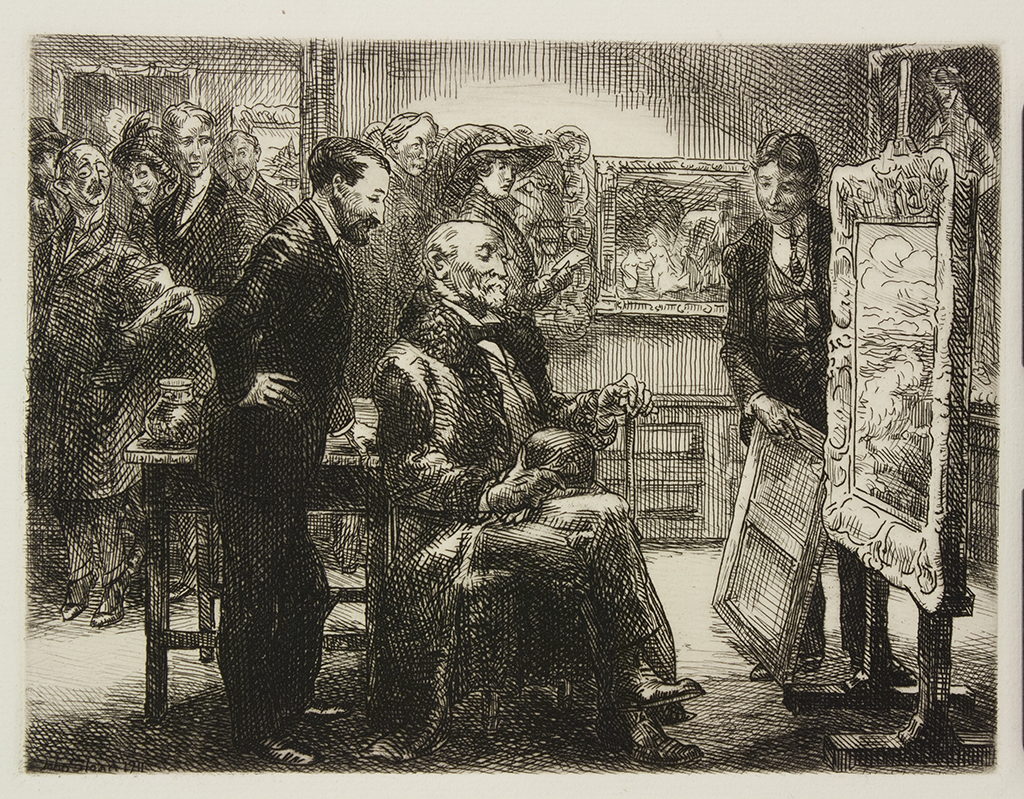
The Picture Buyer
John Sloan
1911
Etching
Edition of 100
9 1/2 in. x 6 3/4 in. (24.13 cm x 17.15 cm)
Gift of Richard E. Bishop in memory of Mary E. Harrington
1962.141.b
Light is evenly distributed across this composition. Though there is clearly one figure of importance in the context of the scene, light does not reflect this. Rather, having each figure uniformly illuminated, suggests that light is used as a way to note some level of social equality among the patrons.
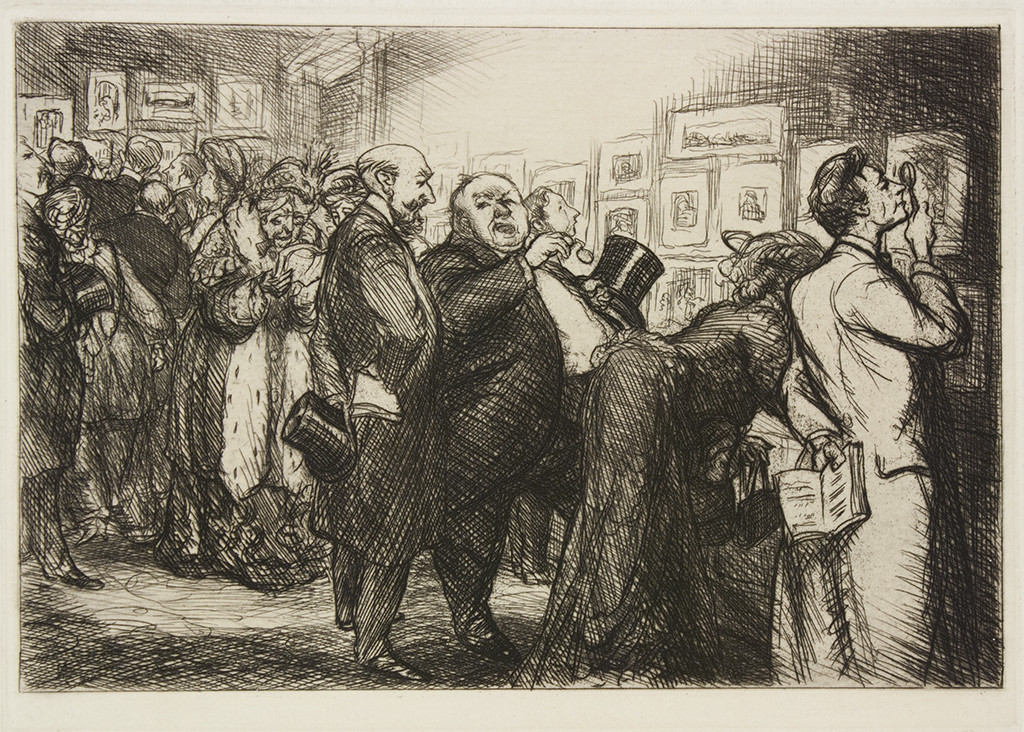
Connoisseurs of Prints
New York City Life series
John Sloan
1905
Etching
Edition of 100
5 in. x 7 in. (12.7 cm x 17.78 cm)
Gift of Richard E. Bishop in memory of Mary E. Harrington
1962.141
Sloan uses light in this scene to create a focal point near the top of the image. It is brightest above the heads of the two central figures, suggesting that Sloan is signalling the perceived knowledge of these two men to his viewer.
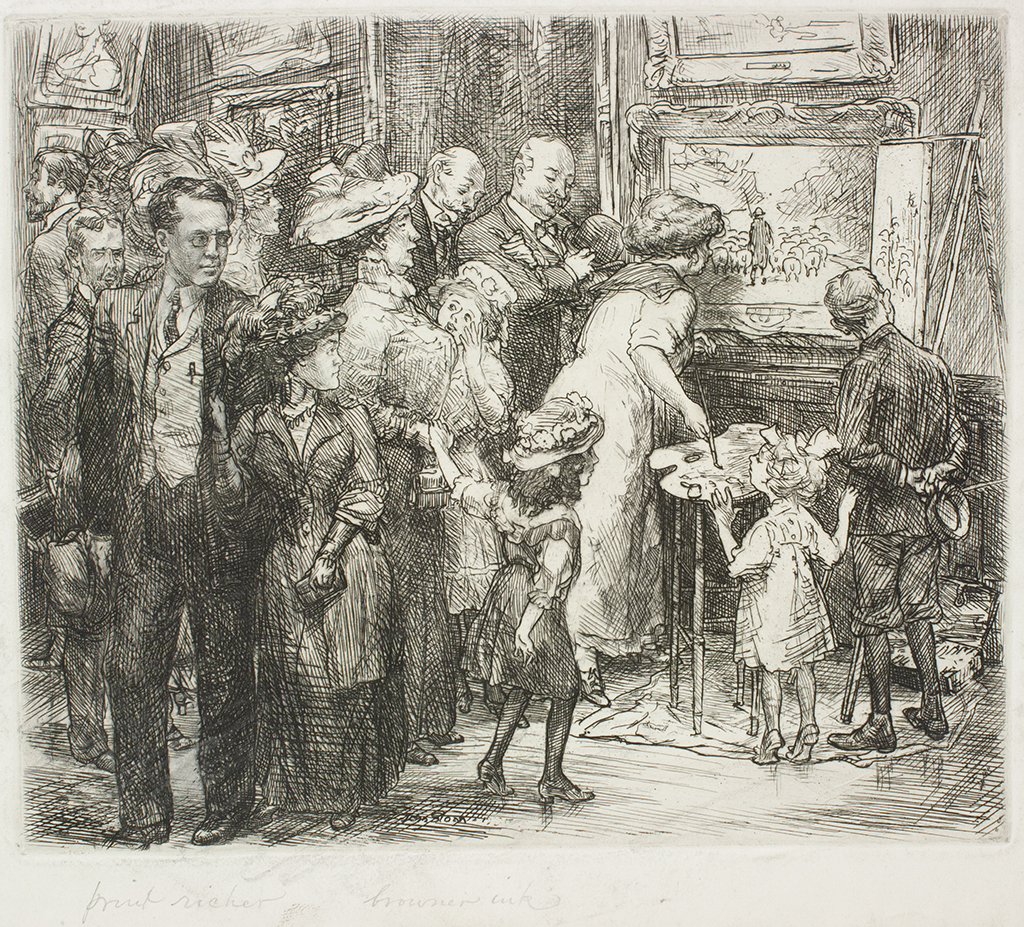
Copyist at the Metropolitan Museum
John Sloan
1908
Etching
Edition of 100
7 3/8 in. x 8 7/8 in. (18.73 cm x 22.54 cm)
Gift of Richard E. Bishop in memory of Mary E. Harrington
1962.110
Sloan uses light to draw attention to the faces of the copyist’s audience. There is a stark contrast between the darkness of these figures’ bodies, and their illuminated faces that are begging for a peek at the display in front of them.

Fifth Avenue Critics
New York City Life series
John Sloan
1905
Etching
Edition of 100
4 3/4 in. x 6 7/8 in. (12.07 cm x 17.46 cm)
Gift of Richard E. Bishop in memory of Mary E. Harrington
1962.144.b
The viewer’s eye is drawn to the two women in bright white dresses set against the dark surroundings of their carriage and the city street. In spotlighting these women through the contrast of light and dark, Sloan uses light to suggest the social status of the women in relation to those surrounding them.


